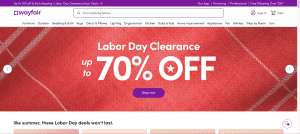
Target price matching has become a key tactic as Walmart and Target, both heavyweights in the retail industry, continuously influence and respond to each other’s strategies. In such a competitive landscape, the pricing strategies of these two giants are pivotal in attracting price-sensitive customers and maintaining market dominance.
Walmart, well-known for its “Everyday Low Prices” philosophy, often dictates market trends, while Target seeks to balance quality and affordability to appeal to a different consumer segment.
By closely watching their competitors, companies like Walmart and Target can swiftly adjust prices, ensuring they remain attractive to consumers. This constant vigilance is not just a practice of smaller players but a necessity for even the largest retailers.
Walmart, with over 4,700 stores in the U.S. alone, and Target, with more than 1,900 stores, both understand the critical role of pricing in maintaining their substantial market shares.
This article explores how these strategies unfold in practice and what they mean for the broader retail landscape.
Understanding the High-Stakes Retail Competition
Today’s retail market is more competitive than ever, with consumers demanding low prices and high-quality products. Walmart and Target, as industry giants, are at the forefront of this battle, constantly adapting their strategies to meet consumer expectations.
With its “Everyday Low Prices” model, Walmart sets a pricing standard that many other retailers, including Target, must acknowledge. This approach forces Target to continuously monitor and adjust its prices to stay relevant in a market where even slight pricing differences can sway customer decisions.
Walmart‘s aggressive pricing strategy often leads to price wars, where competitors like Target must decide whether to match these prices or differentiate through other means. For example, when Walmart slashes prices on essential goods, it pressures Target to respond by offering similar deals or emphasizing the added value of its product selection.
Target, known for its focus on quality and style, often counters Walmart‘s low prices, exclusive brand collaborations, and a curated shopping experience that appeals to a different demographic.
Target‘s strategy also involves regular promotional offers, such as seasonal sales and exclusive discounts through its Target Circle loyalty program. These promotions are designed to retain customers who Walmart‘s lower prices might otherwise tempt.
By blending affordability with a superior shopping experience, Target aims to maintain its market share without directly engaging in a price war with Walmart.
The Role of Target Price Matching Policies
Target and Walmart understand the importance of competitive pricing, but their approaches to price matching reveal distinct strategies.
While Walmart has shifted away from competitor price matching, Target continues to use this policy as a critical part of its pricing strategy.
Walmart’s Price Matching Evolution
Walmart’s price matching policy has seen significant changes over the years, reflecting the company’s evolving strategy:
Ad Match Guarantee: Introduced as a way for customers to bring in lower prices from competitors, which Walmart would match at the point of sale.
Savings Catcher Program: Automated the price matching process by comparing prices after a purchase, simplifying customer experience.
Current Strategy: As of June 2023, Walmart no longer matches competitors’ prices, focusing instead on consistency within its stores and online platforms. This shift highlights Walmart‘s confidence in its low pricing model and operational efficiency.
Target Price Matching Guarantee: A Strategic Approach
On the other hand, Target continues to emphasize its Target Price Matching Guarantee, which was introduced in 2013.
This policy allows:
1. Competitor Price Matching: Customers can request a price match if they find a lower price on an identical item at a local competitor or on Target’s website.
2. Inclusion of Walmart.com: Target even matches prices from Walmart.com, showcasing its commitment to staying competitive.
3. Customer Assurance: This policy is part of Target’s broader strategy to offer reassurance and convenience, ensuring customers feel confident they get the best possible deal.
While Walmart has chosen to focus on maintaining low prices across the board, Target’s ongoing commitment to Target Price Matching underscores its strategy of building trust and loyalty by providing competitive pricing with added convenience.
How Walmart Maintains Its Pricing Dominance
Walmart’s pricing strategy revolves around its “Everyday Low Prices” (EDLP) model, a cornerstone of its success. This strategy is designed to offer customers consistently low prices without relying on frequent sales or promotions, which can be unpredictable and confusing for shoppers.
Walmart achieves this through several key methods:
1. Supply Chain Efficiency
Walmart‘s ability to maintain low prices starts with its highly efficient supply chain. The company invests heavily in logistics technology, allowing it to move products quickly and cost-effectively from suppliers to stores. This efficiency reduces operational costs, which Walmart then passes on to customers at lower prices.
2. Bulk Purchasing Power
Walmart‘s vast size and global reach give it substantial purchasing power. By buying in bulk, the company secures significant discounts from suppliers, further driving down costs. These savings enable Walmart to offer lower prices on various products, from groceries to electronics.
3. Strong Supplier Relationships
Walmart cultivates long-term relationships with suppliers, negotiating deals that benefit both parties. Suppliers often agree to lower their prices in exchange for Walmart’s commitment to purchase large volumes over extended periods. These relationships allow Walmart to maintain its low-price strategy while ensuring a steady supply of products.
4. Private Label Brands
Walmart also leverages its private label brands, such as Great Value and Equate, to offer even lower prices. These brands are developed in-house and sold exclusively at Walmart, allowing the company to control production costs and pricing. By providing these products as affordable alternatives to national brands, Walmart attracts cost-conscious shoppers and reinforces its price leadership.
5. Omnichannel Pricing Consistency
Walmart ensures its low prices are consistent across its physical stores and online platforms. This uniformity strengthens its omnichannel strategy, providing a seamless shopping experience for customers who can trust they get the same great deal, in-store or online. By eliminating price discrepancies between channels, Walmart builds customer loyalty and simplifies shopping.
Through these methods, Walmart maintains its dominance in the retail market by consistently offering low prices that are hard for competitors to match. This approach drives customer loyalty and reinforces Walmart’s reputation as a price leader, making it the go-to retailer for budget-conscious consumers.
How Target Balances Pricing with Quality and Style
Target sets itself apart from Walmart by focusing on a pricing strategy that blends value with quality. While Walmart is known for its aggressive pricing, Target seeks to create a unique shopping experience that appeals to consumers looking for more than the lowest price.
Here’s how Target achieves this balance:
1. Curated Shopping Experience
Target‘s approach centers on offering a carefully curated selection of products emphasizing style and quality. Unlike Walmart, which focuses heavily on price, Target selects merchandise that aligns with its brand image and customer preferences. This includes offering trendy apparel, stylish home goods, and exclusive product lines that cater to customers who value design and innovation.
2. Exclusive Brand Collaborations
Target frequently partners with well-known designers and brands to create exclusive collections. These collaborations, such as those with Hunter, Magnolia by Chip and Joanna Gaines, and Disney, allow Target to offer unique products that can’t be found at other retailers. These exclusive lines often justify slightly higher price points, as customers are willing to pay more for items perceived as higher quality or on-trend.
3. Promotional Strategies
Unlike Walmart‘s everyday low pricing model, Target employs various promotional strategies to attract customers. These include weekly sales, seasonal promotions, and clearance events, which create a sense of urgency and encourage shoppers to take advantage of deals while they last. Target‘s promotion approach allows pricing flexibility, enabling the company to introduce discounts without compromising its brand’s perceived value.
4. Loyalty Programs
Target Circle, Target’s loyalty program, plays a crucial role in its pricing strategy. This program offers personalized discounts and rewards based on customer shopping habits, fostering customer loyalty and encouraging repeat business.
Additionally, the RED card program provides cardholders with ongoing discounts and exclusive offers, further enhancing Target’s value proposition.
- Flexibility in Pricing
- Target’s pricing strategy is more flexible than Walmart’s, allowing it to introduce higher price points for premium or exclusive products. This flexibility enables Target to cater to a broader range of customers, from those seeking affordable basics to those seeking higher-end goods. By offering a mix of price points, Target appeals to budget-conscious shoppers and those willing to spend more for quality and exclusivity.
Through these strategies, Target successfully balances affordability with quality, attracting a diverse customer base that values both price and the shopping experience.
This approach allows Target to differentiate itself from Walmart and build a loyal customer following that appreciates the blend of style, value, and quality that Target consistently offers.
The Price Battle: Is Target Price Matching Walmart?
While Target has mechanisms to match Walmart‘s prices, it is not solely dependent on this strategy. Target Price Matching is just one tool among many in its broader pricing strategy, including customer loyalty programs, promotional events, and exclusive product offerings.
Therefore, while Target monitors and sometimes matches Walmart‘s prices, its overall strategy focuses on maintaining a brand identity that blends affordability with quality and style.
FAQs
Q: Does Target price match after purchase?
A: Yes, Target offers price adjustments within 14 days of purchase if you find a lower price at Target or select competitors.
Q: How does Walmart’s elimination of price matching affect consumers?
A: While consumers can’t request price matches, Walmart aims to maintain consistently low prices across all its channels.
Q: Can I use Target’s price match guarantee online?
A: Yes, Target offers price matching for online purchases, but you need to contact their customer service to request it.
Q: How do Walmart and Target’s pricing strategies affect their profitability?
A: While low prices can reduce profit margins, both companies leverage their scale and efficient operations to maintain profitability.
Q: Does Target price match with Amazon?
A: Yes, Target does price match with Amazon.com, but only for items sold and fulfilled directly by Amazon, not third-party sellers.
Q: How often do Walmart and Target change their prices?
A: Both retailers adjust prices frequently, sometimes daily, based on factors like competitor pricing, supply and demand, and inventory levels.
Q: Are Walmart’s prices always lower than Target’s?
A: Not always. While Walmart generally aims for lower prices overall, Target may have better prices on certain items, especially during promotions or for their exclusive brands.
Q: How do I know if I’m getting the best deal between Walmart and Target?
A: Compare prices using each store’s app or website, consider any ongoing promotions or loyalty program benefits, and factor in the convenience and shopping experience that matter to you.
Q: Do Walmart and Target price match their own online prices in-store?
A: Target typically matches its own online prices in-store. Walmart generally aims for consistent pricing across channels but may have some variations.
Q: How do seasonal sales affect the pricing strategies of Walmart and Target?
A: Both retailers offer significant discounts during major shopping seasons (like Black Friday or Back-to-School), often using these events to attract customers and compete more aggressively on pricing.
Q: What role do private label brands play in the pricing strategies of Walmart and Target?
A: Private label brands allow both retailers to offer lower-priced alternatives to national brands, giving them more control over pricing and potentially higher profit margins.
Q: How do Walmart and Target’s pricing strategies differ for groceries versus general merchandise?
A: Both tend to be more competitive on grocery prices due to higher purchase frequency. For general merchandise, Target often positions itself as offering higher quality at a slight premium, while Walmart maintains its everyday low price strategy.
Q: Do Walmart and Target offer price protection for future price drops?
A: Target offers price adjustments within 14 days of purchase. Walmart discontinued its price protection policy, focusing instead on maintaining low prices from the outset.
Q: How do online marketplaces like Amazon influence Walmart and Target’s pricing strategies?
A: The presence of online marketplaces has pushed both retailers to be more competitive with their online pricing and to improve their e-commerce capabilities, including faster shipping options.
Q: Are there any items that Walmart or Target won’t price match?
A: Yes, both retailers have exclusions. Common ones include clearance items, limited-time promotions, and competitor’s doorbusters or lightning deals. Always check their current price matching policies for specific exclusions.
Wrapping Up
Target Price Matching is crucial in maintaining Target‘s competitiveness in the ongoing battle between Walmart and Target. By allowing customers to match prices from competitors, Target ensures that it remains a viable alternative to Walmart, especially for price-sensitive shoppers.
However, Target‘s broader strategy, which includes promotions, exclusive products, and loyalty programs, ensures that it stands out as a retailer that offers more than just low prices.
Pricefy can help you implement these strategies precisely, ensuring you stay competitive in the fast-paced retail environment. Our dynamic pricing tools allow you to effectively monitor your competitors and make informed pricing decisions.




